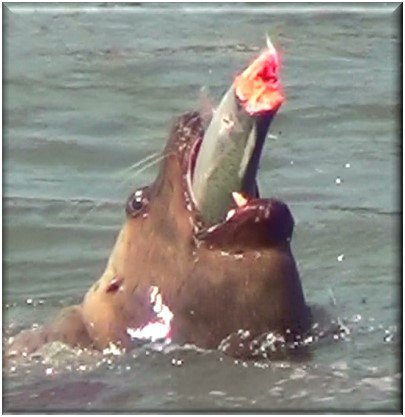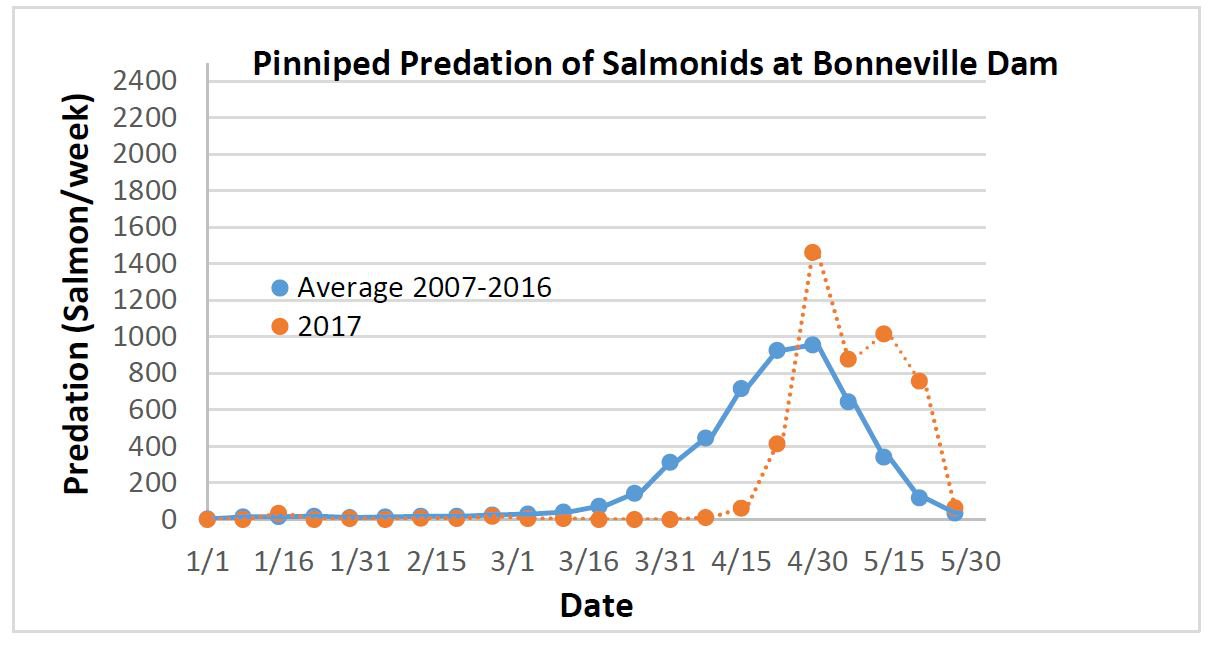More Sea Lions, Fewer Fish
A preliminary report suggests sea lions may have killed a large portion of this year's diminished spring Chinook salmon run at Bonneville Dam
- June 09, 2017
- John Harrison

Preliminary data compiled by the U.S. Army Corps of Engineers suggests that high numbers of sea lions in the tailrace of Bonneville Dam may have killed a large portion of the spring Chinook salmon run this year, which was far lower than predicted.
In the fourth and final report of pinniped (seals and sea lions) monitoring at the dam in 2017, the Corps estimates that about 5,000 adult salmon and steelhead were consumed between January and the first week of June – 82 percent of them Spring Chinook, a run that includes threatened and endangered species. Pinnipeds also were observed killing White Sturgeon and Lamprey at the dam, but in much smaller numbers.
A final report on 2017 predation at the dam will be released later this year.
According to the preliminary report, “The reduced salmonid runs and persistently high numbers of pinnipeds in the latter part of the season suggests that the total impact by pinnipeds on this year’s salmonid run may be large.”

Chart: U.S. Army Corps of Engineers
Observers reported that between May 13 and June 2, the last of four reporting periods, pinniped numbers at Bonneville Dam were higher than the 10-year average. Pinnipeds captured (the report uses the term “depredated”) 63 salmonids (salmon or steelhead). The observers also reported that predation lagged this year compared to previous years, increasing in the last month or so. This likely was because the fish arrived at the dam later this year than in previous years, according to the report. The dominant species in the tailrace was Steller sea lions (about 24 per day were observed), followed by California sea lions (about 13 per day). One Harbor Seal was seen earlier in the year.
Most of the Steller sea lions were gone by May 27; none was observed by June 2. Most of the California sea lions were gone by May 30; only one was observed at the dam by June 2. In all, during the 2017 predation season observers documented 15 Steller and 88 California sea lions as uniquely identifiable individuals. All of them had been either seen at the dam in previous years or were recently branded for future identification.
The 2017 spring Chinook run was far below expectations. In February, Oregon and Washington fish managers predicted a return of 160,400 fish crossing Bonneville Dam. In early June as the run wound down, the states revised the forecast to 118,000.
According to the Fish Passage Center, by June 8 the count was 83,624 adult fish and 18,110 jacks. The 10-year average through that date is nearly twice as many: 150,783 adults and 25,708 jacks. A year earlier, on June 8, 2016, the count was 137,215 adults and 11,145 jacks. Researchers say a major factor in the low 2017 return may be poor ocean feeding conditions when this year’s returning adult fish migrated to the ocean as juveniles. Many may have starved.
Between 2004 and 2016, California and Steller sea lions are estimated to have taken about 68,000 adult salmon and steelhead in the Columbia River near Bonneville Dam, the first dam salmon and steelhead encounter when they return from the ocean to spawn. In addition, between 2006 and 2016, Steller sea lions are believed to have consumed approximately 12,500 white sturgeon below the dam. Sea lion predation on Pacific lamprey has also increased in recent years with 85 taken in 2014, 196 in 2015, and 501 in 2016.
These numbers, however, reflect only the fish observed being consumed within 1/4 mile of Bonneville Dam. State and federal researchers who have studied predation in the entire 146 miles between the ocean and the dam believe that a significant portion of the annual spring Chinook salmon run is lost to marine mammal predation. State researchers estimate that about 20 percent of the spring Chinook run is lost to sea lions, while a NOAA Fisheries researcher, Dr. Michelle Wargo-Rub, believes it is far higher. According to her study, as much as 45 percent of the spring Chinook run disappeared in 2016, and much of that loss is likely attributed to sea lions. This translates into a potential loss of between 34,000 and 78,000 spring Chinook salmon in 2016.
The Council supports H.R. 2083, the Endangered Salmon and Fisheries Predation Prevention Act, bipartisan legislation introduced by Congresswoman Jaime Herrera Beutler and Congressman Kurt Schrader. The Council sent a letter of support for the legislation on June 7 in advance of a hearing held by the House Subcommittee of Water and Power.


